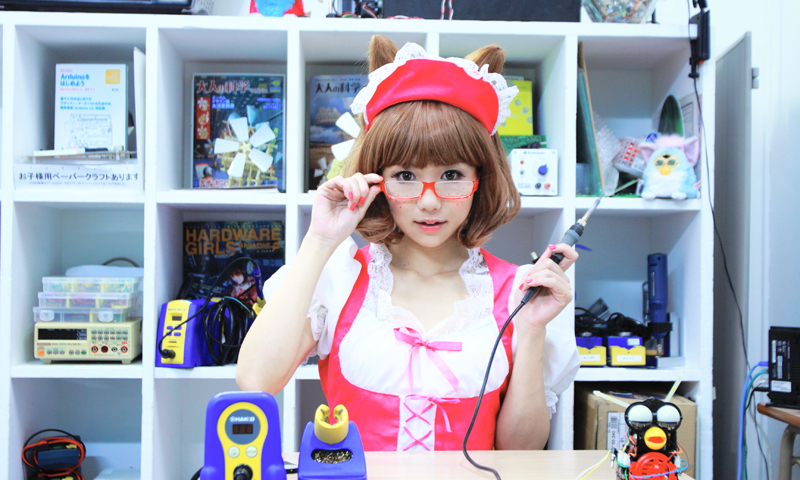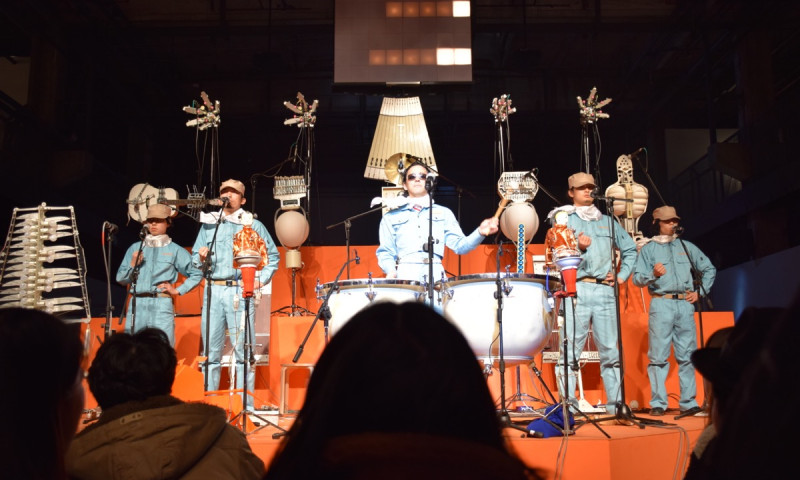
TOKYO CUTTING EDGE CREATORS by Julie Watai #11 featuring Frenesi: The Singer-Songwriting-Animator


Sponsored Links
TOKYO CUTTING-EDGE CREATORS by Julie Watai is column series, which covers Tokyo’s latest cutting-edge culture! In this series she’ll be interviewing creators that have caught her interest, in order to discover the latest cutting-edge culture in Tokyo. For our first installment, we interviewed artist Ai☆Madonna, and for the second time, we’ll be interviewing Junya Suzuki, who has been working for fashion label “chloma”.
東京の最先端カルチャーを常に追いかけ続けてきたJulie Wataiさんの連載『TOKYO CUTTING-EDGE CREATORS by Julie Watai』。この連載では、Julie Wataiが注目するクリエイターとの対談を通じ、新たな東京の最先端カルチャーを発見していきます。初回では愛☆まどんなさんと対談を行い、第2回目となる今回は、ファッションレーベル”chloma”の鈴木淳哉さんにインタビューさせて頂いております。
Julie: Hello! Long time no see!
Julie: こんにちは。お久しぶりです!

This interview was conducted via Skype./対談はSkypeチャットでやってます。
Julie: Excuse me for getting started so quickly, but I think there people out there who haven’t yet heard of the fashion brand you’ve been working on, chloma. Could you tell us a little about the brand’s concept?
Julie : 早速なんですが、初めて知る方もいらっしゃるかと思いますので、鈴木さんの手がけている服飾ブランド「chloma」のコンセプトを教えてください。
Junya Suzuki (Suzuki): It’s a fashion label designed by Reiko Sakuma and myself, taking into consideration the relationship between people and technology, people and characters and people and the internet, taking influence from the world with our monitors and modern people who traverse the real world without borders.
鈴木淳哉(以下、鈴木): テクノロジーと人、キャラクターと人、インターネットと人との関係を考え、モニターの中の世界とリアルの世界を境なく歩く現代人のための環境と衣服を提案する鈴木淳哉と佐久間麗子によるファッションレーベルです。

You can browse their website for 3D models of their clothing. /公式ウェブサイト。3Dモデルを操作、閲覧できる。
See chloma website : http://www.chloma.com/
Julie: So it’s a two-unit brand, right? How do you both decide your roles during the production process?
Julie: chlomaはお二人でのユニットなんですよね。制作での役割分担などはどうなっているのでしょうか?
Suzuki: I do a large share of the design work, while Ms. Sakuma does the patternmaking. However I also do pattern work, and Ms. Sakuma also designs.
鈴木: 大きな役割は僕鈴木がデザイン、佐久間がパターンですね。僕もパターンを、佐久間もデザインをやりますが。
Julie: I see. Come to think of it, I remember your previous brand had a slightly different design. Is there anything that inspired your current style?
Julie: そうなんですね。そういえば、以前の鈴木さんのブランドはちょっと違うデザインだったように記憶してます。今のスタイルになったのは何かきっかけってあったのでしょうか?
Suzuki: This first brand I did was called Junya Suzuki. After Ms. Sakuma and I really began to work together as a team, we decided to change the name and renamed it to chloma. The evolution of the brand’s style was a result of deciding to bring our clothing to the city, instead of just focusing on designs and costumes aimed at a limited group of people.
鈴木: 最初はJunya Suzukiという僕の名前でブランドをやっていました。Chlomaに改名したのは佐久間と本格的に一緒に活動をするようになってブランド名を改めようとなったのがきっかけです。スタイルの変化は、衣装や限られた人向けのデザインの服ではなくて、街に届けられる服をやっていこうという決意があったからですね。
The reason behind this was that although some people may not care much about what kind of clothing they wear, most people in public do. If what they’re wearing is out-of-fashion, it may lower their value in the eyes of others. People are very sensitive to fashion in this age, and we thought it would be more fun to challenge that.
その理由としては、衣装は着る人があまり責任を負わないですが、街で着る服は着る人に大きな責任があります。ダサかったらその人の価値を低く見せてしまう。時代性に非常に敏感で、その時代性に対して勝負していく方が楽しいだろうと。
Julie: So each design focuses on people being able to wearing your label around the city. There’s definitely a personal touch there, as your designs that give off a futuristic impression, yet remain understated.
Julie: chlomaは街で着る服を意識してのデザインなんですよね。主張があるけど目立ちすぎることもなく、未来的なデザインだなという印象があります。どんな人やどのようなシーンで着てもらいたいというイメージはあるんですか?
Suzuki: We want people to be able to wear our clothing anywhere. Without sacrificing our vision, we want people to feel safe wearing our clothing around their local neighborhood.
鈴木: どこでも着てもらいたいですね。夢がありつつも、地元の住宅街で着ていてもセーフでありたいです。
Julie: Around their local neighborhoods! That would certainly be cool. (laugh) I always regarded it as an urban label, and hadn’t thought of it like that.
Julie: 地元の住宅街! それはそれでかっこいいシチュエーションかも(笑)。すごく都会的な印象があったのでその発想はなかった。
Suzuki: Even as we create a futuristic, urban image, we don’t want it to stand out in a negative way too much.
鈴木: 都会的未来的なイメージを作りつつも、悪目立ちしすぎないようにありたいです。
Julie: By the way, would you mind going into more detail about your career history? I assume you went to fashion school, right?
Julie:ちなみに鈴木さんの経歴も教えてもらいたいんですが、やはり服飾学校に通われてたんですか?
Suzuki: After attending a four-year university, I went to a Japanese fashion college for two years in Japan, studied abroad in Paris for a year, and then came back to start Junya Suzuki.
鈴木:経歴ですが、僕は4年制大学を出た後に日本の服飾専門学校に2年、パリへの留学が1年あり、帰国後にJunya Suzukiをスタートしました。
Julie: How long did Junya Suzuki last, or are you still continuing with it?
Julie: Junya Suzukiはどのくらいの期間されていたのでしょうか。今も継続されていたり?
Suzuki: I’m no longer working on that label, but I think I continued with it for about a year under the Junya Suzuki name.
鈴木: 今は継続していないですね、Junya Suzuki名義での活動は1年程度だったかと思います。
Julie: Then after that, you started chloma. I’ve seen one of your Junya Suzuki collections before, and I felt like it was really is high-end fashion! It seems to me the support chloma is getting is a result of targeting a different group than you did before. To put it simply, people that like anime and the like. I think the way you approached this group through fashion is really groundbreaking! When you released your Nendoroid Coat, how was the response from those close to Akihabara culture?
Julie: その後、chlomaがスタートした、と。Junya Suzukiのコレクションを拝見したことがあるのですが、本当にハイファッション!という印象でした。chlomaではこれまでのターゲット層と全く違う層から支持されているのかなと思います。平たく言うと、アニメなどが好きな人たちからも。それで、この層へ人たちへのファッションでのアプローチというのは画期的だと思いました!「ネンドロイドコート」などのお洋服をリリースした時、秋葉原文化に近い方たちからの反響はどうでした?

Nendoroid Coat/ネンドロイドコート
Suzuki: Maybe this isn’t a great explanation, but I wanted to paint an SF (science fiction) world were “normal people” are the main characters. I thought with the internet era, it would be possible. The “those into Akihabara culture” label is much too vague now, and the with the previous wall between fashion and otaku like oil and water gone, it felt like people took to it naturally.
鈴木: こういう言い方は良くないかもしれないですが、「普通の人」が主役のSF世界を描きたいと思うようになりました。インターネットの時代ならそれが可能だと。「秋葉原文化の人たち」という括りが曖昧になってきていた時期でもあり、以前は水と油だったファッションとオタク文化の壁が無くなってきていたので、自然に受け入れてもらえたように感じます。
Julie: I get that. When you wear chloma brand clothing, it really does feel like you’re the main character of an SF world. I also own the (poncho-type) coat. It’s design has a lot of character, and whenever I wear it people always give me compliments and ask me where I got it.
Julie: うん。chlomaの服を着るとSF世界の住人になれたような気分になりますね。私もコート(ポンチョタイプ)持ってます。特徴のあるデザインだし、着ていると「どこで買ったの?」ってかならず褒められますね。
Suzuki: I think we’ve gotten a lot of support from those into fashion, but also those into fashion and otaku culture. Then when people who were only into otaku culture understood the narrative surrounding our clothing, they also came on board. Using plastic models and figures as a reference, we were able to create a soft look with thick wool, allowing it to sit on the balance between that SF and real world feel.
鈴木: ファッション好きな人、ファッション/オタク文化の両方が好きな人から支持して頂けたと思います。オタク文化オンリーの人は、服にまつわる物語性から理解してくれて、入ってきて下さったりもしました。プラモ、フィギュアの造形などを参考にしつつ、肉厚のウールで柔らかい表情で作る事によって、SF感とリアル感のバランスを取るようにしました。
Julie: Before grown-ups were categorized as “otaku” just for watching anime as adults, but now it seems like this is new viewed as “normal”, and it’s not uncommon to listen to Hatsune Miku or have figures. It’s not strange to find people part of this new generation who appreciate fashion and anime as points on the same axis.
Julie: 以前では成人がアニメを見るだけで「オタク」とカテゴライズされていたのが、今や全くそんなことは「普通」になっていて、初音ミクの曲聴くとかフィギュア持っているのとかも珍しくないという状況ですもんね。そんな新世代の人たちにとっては、ファッションもアニメも「同じ軸で好き」という気持ちがあってもおかしくないですね。
Suzuki: I think that’s exactly it. People represent themselves both through characters and fashion, so it’s natural to like both.
鈴木: 全くそうですね、キャラクターもファッションも人にまつわる表現なので、どちらも好きというのはとても自然な事だと思います。

Photographer: Julie Watai Models: Julie Watai & ASUNA, Taken in 2014. Items Watai borrowed and used from chloma appear in her collaborative work LOVE VALLEY with Android ASUNA. 2014年撮影。アンドロイドASUNAとの作品群「LOVE VALLEY」ではchlomaの作品をお借りし、着用している
Julie: Changing the topic a little, I think the way your website changes with each collection is really interesting. For your 2016 Spring/Summer Collection, you combined two-dimensional characters with real background images, and each time you scrolled down there was a dynamic amount of image movement. My friend in web design said that she thought the chloma site was great. Where do you get inspiration for these kinds of ideas?
Julie:話は変わるのですが、コレクションごとに変わるオフィシャルサイトもすごく面白いデザインですよね。2016年s/sでは、二次元キャラと実写の背景の合成や、画面をスクロールさせるとダイナミックな画像の動きがあったり。webデザイン関係の友人もchlomaのサイトはすごくいいと言っています。こういったアイデアはどこからインスパイアされているのでしょうか?

From the 2016 Spring/Summer Collection website. Illustration: TOKIYA SAKBA 2016 S/S コレクション ウェブサイトより。イラスト:TOKIYA SAKBA
Suzuki: I’m glad to receive such a compliment from one of your friends! I think the inspiration behind it came from video games. In games, graphics appear on screen together with a story. Currently these representations on screen have gained a wide social standing.
鈴木: Julieさんのご友人から褒めて頂けてとても嬉しいです! インスパイアは、やはりゲームかなと思います。ゲームは、画面の中で物語がグラフィックと共に展開されていく。現代は、その画面の中の表現が広く社会性を持つようになりました。
Julie: Now I’m curious to hear what your favorite game is!
Julie: 鈴木さんの好きなゲーム、知りたいです!
Suzuki: The game that sucked me the most was “Tactics Ogre: Let Us Cling Together” on the Super Nintendo in Japan, and recently I’m really into the game “Portal” available on Steam (Note : an online platform for PC game downloads). Both of the games are really legendary.
鈴木: 僕が一番ハマったゲームはスーパーファミコンの「タクティクスオウガ」、最近のゲームだとSteam(編注:PCゲームのダウンロード販売プラットフォーム)でダウンロードできる「Portal」ですね。どちらも本当に神ゲームです。
Julie: Being part of the Super Nintendo generation, Tactics Ogre really is a nostalgic one…
Julie: スーファミ世代だったんですね、「タクティクスオウガ」懐かしい……。
Suzuki: Portal has a pretty distinct chloma style to it.
鈴木: 「Portal」は、けっこうダイレクトにchlomaっぽいかと。
Julie: Isn’t Steam a site where you can download indie games? I’ll give “Portal” a try!
Julie: Steamって、インディーズゲームがダウンロードできるサイトでしたっけ。「Portal」やってみます!
Suzuki: Well, not only indie games, but, for example, games that were released on the PlayStation and XBOX. It’s still not very big in Japan yet. It depends on when you buy it, but I think you can get it for about 1,000 – 1,500 yen… I think you would definitely enjoy it! It’s even won an award from the GDC, so you can trust it’s good. (Note: GDC stands for the Game Developers Conference, and is like an academy awards ceremony for games. It won the 2012 Game of the Year award.)
鈴木: いえ、インディーズゲームだけではなく、例えばプレステやXBOXで出ているゲームなんかもあります。日本での普及はまだまだみたいですが。「Portal」は時期によりますが1000円~1500円くらいで買えるんじゃないかな……Julieさんも絶対好きだと思うので是非! 「Portal」はGDCアワード(編注:「GDC」は、ゲームのアカデミー賞とも言われる「ゲーム・ディペロッパーズ・チョイスの略)という賞の2012ゲーム・オブ・ザ・イヤーになっているので折り紙つきです。
Julie: Is that so! They have a lot of games and I’ve glanced over the site before, but it feels a little like digging a moat. By hitting on the topic of games, I seem to have gotten a closer glimpse at one angle of your personality. (laugh) Come to think of it, the NHK program Sakidori introduced a VR (virtual reality) and chloma collaboration on the show that aired April 3rd. It was a demonstration with VR glasses that showed people having fun shopping for real clothes in a virtual world.
Julie: そうだったんですね。色々なゲームがあってちらっと見てはいましたが、堀り甲斐のありそうなサイトですよね。ゲームの話を振って、うっかり鈴木さんのディープな一面を垣間見てしまったようです(笑)。そういえば4/3に放送されたNHK の番組「サキどり」では、chlomaの服とVR(バーチャルリアリティ)のコラボが紹介されていましたよね。実在する服をバーチャルの世界で楽しみながらショッピングを体験する、VRグラスを使ってのデモンストレーションでした。

chloma x Psychic VR Lab VR Store Demonstration
Julie: I was able to see the process of 3D scanning clothes on chloma’s instagram, yet it was sill so surprising to see them appear in VR. It really fits in nicely with the brand’s image, though, doesn’t it?
Julie: chlomaのインスタグラムで服の3Dスキャンの制作過程を拝見していましたが、まさかVR用の撮影だったなんて、驚きました。でもブランドイメージにしっくりきますね。
Suzuki: Presently it still costs quite a bit to get clothes 3D scanned, but Psychic VR Lab said they wanted to use our clothes for this show’s demo, so they were able to scan many items for us.
鈴木: 現在ではまだ服を3Dスキャンをしてもらうには結構なコストがかかるのですが、Psychic VR Labさんが今回の番組のためにデモを作るというので、そのためにchlomaの服を使わせて欲しいと言って頂いて、たくさんの服をスキャンしてデータにしてもらう事ができました。
Julie: Even the people from the Psychic VR Lab that put on the show were wearing chloma clothing. During the program we were able to view the clothing items from all angles, and they performed a demonstration of buying them through VR. Do you have plans to turn this into something practical?
Julie: 番組に出てらっしゃったPsychic VR Labの方たちもみなさんchlomaの服着てましたね。番組中ではchlomaの服が立体的に色々な角度から見れて、VR上からも購入ができるというデモをしていましたね。実用化する予定はありますか?
Suzuki: Of course I would love to be able to make chloma clothes available for purchase that way, however it might be tough to only display them in 3D in VR space, given the limitations that most PCs still have. We want to make 3D model shopping a thing sooner than later, though.
鈴木: 実際にchlomaの服をそうやって購入できるようにしたいという思いはもちろんあります。でも、3Dモデルの表示だけならまだしも、VR空間で、となると一般的なPCの能力ではまだ少々厳しいかもしれませんね。3Dモデルを閲覧してもらってのショッピングは、遠からぬうちに是非実現したいです。
Julie: I see. It’s likely that the image resolution and processing speed is likely to increase from here on out, so it’s something to look forward to realizing in the not too distant future. I certainly hope chloma is the first one to do it.
Julie: そうですね。VRでの画像の解像度や処理速度もこれからどんどん上がっていくのでしょうし、そう遠く無い近未来での実現を楽しみにしています! ぜひchlomaに一番先にやってもらいたいです。
Last, I’d like to ask you about your future ambitions, and could you tell us what you’re working on next?
最後のご質問なのですが、鈴木さんの今後の野望や、次の制作などについて教えてもらえますか?
Suzuki: As far as work goes, I want to be able to make a low-key announcement about my collection in six months. Looking at my current plans, I think they’ll be full of bright visuals. I have an exhibition scheduled in May. Concerning my future ambitions, I want to bring my perception of fashion to the next stage. Beyond that, a cyber nursing home! (laugh) It would take too long to explain either, so I’ll just leave it at that. (laugh)
鈴木: 仕事については、半年に一度のコレクションの発表を粛々とこなしていきたいですね。今の所の計画では、なかなかはっちゃけたビジュアルになるかと思います。展示会は5月に開催予定です。今後の野望は、ファッションの捉え方をネクストステージに持っていくこと。あとはサイバー老人ホームです!(笑) どっちも長くなりそうな話ですみません(笑)
Julie: Oh, it’ll be bright and lively?! I’m looking forward to seeing it!
Julie: ええっ、さらにはっちゃけてしまいますか!? 次のコレクションも楽しみ!
Suzuki: Thank you!
鈴木: ありがとうございます!
Julie: Um, I can’t help but ask… But a cyber nursing home?! (laugh) Could you go into just a little more detail?
Julie: あの。すごく気になるんですけど。サイバー老人ホームって(笑)! この話詳しくお聞きしてもいいですか?
Suzuki: We want people who like chloma to stay with us until they’re older. This is kind topic kind of goes beyond fashion, but we’ve been thinking about how to enrich older people when they reach a point where they feel they have nothing left to offer society.
鈴木: chlomaを好きになってくれる方と老後まで付き合いたいと考えていて。ファッションよりも少し大きい枠の話になってしまうのですが、老後、自分の社会的な価値がゼロに近づいていったときに、どうその人たちを充実させてあげられるかを考えています。
Julie: I had no idea you were thinking so far ahead already. But I can sympathize. When I think about old age, I think about how there aren’t any cool electric wheelchairs. A part of me has a secret desire to design a really cool one.
Julie: 既にそのステージのことまで考えていたなんて。でも共感できます。私も老後のことを妄想したりするんですけど、かっこいい電動車椅子って無いんですよね。めっちゃクールな電動車椅子をデザインしてみたいという密かな願望は私もあります。
Suzuki: I think that the “kawaii/moe” sensation can also apply to the older people, and although comparatively we currently use that emotion and energy to appeal to young people, in the future I’d like to use them for the elderly. Wheelchairs are bulky, and the competition to make a cooler wheelchair is fierce, so I’d like to come up with a cool, wheelchair design for animals. I like things that have a certain weakness to them… Accepting the part that’s lacking, and taking a story and transforming it to satisfy those feelings is what I believe “moe” is.
鈴木: 僕は、「かわいい/萌え」という感情は、老人に対しても応用できると思っていて、今はその感情とエネルギーを比較的若い人向けに使用していますが、先々は高齢者のために使いたい。車椅子もアツいですね。かっこいい車椅子は競争が激しそうなので、僕は動物用の素敵な車椅子作ってみたいです。僕は弱さを持った存在が好きで……。欠落した部分を認めて、それを、どう感情を充足させるために物語を使って変換するのか、が萌えだったりすると思うので。

From the 2014-2015 Autumn/Winter Collection website. When you scroll down you can see different items mixed and matched. 2014-15 A/W コレクション ウェブサイトより。スクロールで着せ替えするように閲覧できる
Julie: I think chloma is able to convey “moe” through its designs. With its transience and inorganicness, it’s quite convincing. As for a pet wheelchair, I also have a dog, and although it’s just a puppy, I’ve been doing a lot of research now about when she becomes a senior dog, and there aren’t many options. I’d really love to see your design for an animal wheelchair!
Julie: chlomaのデザインにも通じる萌え、あると思います。儚さと無機質さ、なんか納得です。ペット用車椅子、私も犬飼っていて、まだ子犬なんですが今からシニア犬になってからの事を色々調べてるんですけど、やはり選択肢が少ないんですよね。ぜひ素敵なデザインの動物用椅子を出して欲しいです!
Suzuki: I think considering how “moe” feelings apply not only to girls, but to the elderly would substantially make for a brighter future in Japan.
鈴木: 萌え感情を、女の子だけじゃなくて高齢者に応用する仕組みを考えるのは、結構実質的に日本の明るい未来のためになるんじゃないかなって思っています。
Julie: The world would be less dim if there were a variety of options for older people (laugh), and it would be great to imagine a brighter future for Japan. Right now it’s easy to notice all of the negative news in the world. Thank you very much for speaking with me today! Seeing all your different sides has made me like chloma even more.
Julie: 老後に色々な選択肢があって充実した世の中になればボケなさそうだし(笑)、明るい未来が想像できていいですね。今の世の中は暗いニュースが目立つから。鈴木さん、今日はお話ありがとうございました! 鈴木さんの色々な面を知ることができて、ますますchlomaが好きになりました。
Suzuki: The pleasure was mine!!
鈴木: こちらこそありがとうございました!!
After the interview/対談を終えて
chloma has gone beyond fashion, and is continuing its four-dimensional spread. Under his quiet demeanor, Mr. Suzuki has a passionate, inquiring mind and curiosity that is seeking out a new world.
ファッションの領域を超えて、chlomaは四次元的に広がり続けている。一見物静かな人に見える鈴木さんの根底にあるものは、新しい世界を追求したい、という熱い探究心や好奇心だと思う。
His spirit of breaking away from the “hard” impression fashion carries reminds me of the Urahara culture of the previous decade.
ファッションという一見「硬い」入り口のイメージを打ち崩す勢いは、一昔前の「裏原文化」を彷彿とさせた。
People seeking to build their personal image by dressing in high-end fashion brands, aiming to elevate their individual image. However you might say this behavior is already part of the previous decade. That’s because young adults living in the age of expressing their individuality, with respect to the intent of others, have no interest in conforming to the mainstream image.
人々はパーソナルイメージの向上を求めて、大衆がよしと認識する高級ブランドを身にまとい、個人のイメージ向上を図る。しかしその行為自体はもはや一昔前の感覚であると考える。なぜなら個人発信の現代を生きる若者は、個々の意思を尊重するゆえに、大衆のイメージになんて何の興味もないからだ。
chloma easily fits into this age of such individualism. Its emphasis on the inorganic is supported by young adults who every day confidently traverse the rapid pace of online streets, and has become an icon. Wanting to experience these online streets, someone like myself from the previous generation can’t help but keep their eye on what developments from chloma lie ahead.
chlomaはそんな個人主義な時代にするりと馴染んだ。「無機質な主張」はまさに目まぐるしく移り変わるインターネットのストリートを日々闊歩する若者たちに支持され、アイコンになった。ネットのストリートを体感していたい「インターネット旧世代」の私は、今後もchlomaの発信から目を外せない。
Related links
chloma website : http://www.chloma.com/
chloma INSTAGRAM : https://www.instagram.com/chlomagears/
Julie Watai website : http://juliewatai.jp/
Translated by Jamie Koide
Sponsored Links

Babyraids JAPAN Welcome New Challenges in the Dramatic MV for “Senko Believer”!

Risa Satosaki Reveals Everything in the MV for “S!NG”!



